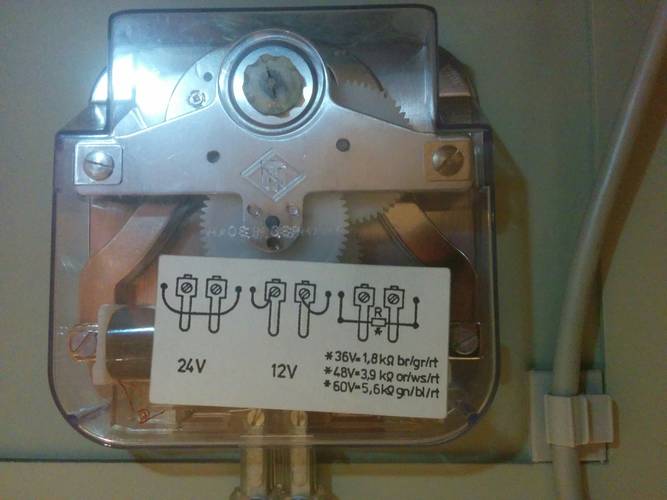The analog clock on those old red Finnish metro station displays is driven by 12 V pulses with alternating polarity. One pulse turns the minute hand one step forward, and the hour hand is automatic. The required pulse duration is typically 0.5 seconds, but I'm using one second here because half is not always enough. Current draw of both the two coils is approximately 50 mA at 12 V.
It's not possible to go backwards electrically, but there is a gear inside that can be turned manually. It's also okay to just grab the minute hand.
This repo contains a super simple script that pulses two Linux GPIOs every minute. This runs on a Raspberry Pi in AS guild room. Those pins are connected directly to an H bridge. TODO: fix the circuit to use enable and direction pins, so that it wouldn't be possible to blow up the transistors.
Setup: run $your_path/clock.sh register as root when booting, e.g. in
/etc/rc.local or use cron's @reboot. This sets up the gpio sysfs
exports.
Realtime operation: run $your_path/clock.sh realtime somewhere, as a normal
user. I still have this in a screen session so that it could be ^Z'd
temporarily while in development. clock.sh [even|odd|both] pulses the even,
odd, or both pins ("even" pin is one that turns the minute hand to an even
number using the H bridge.) clock.sh fast advances the clock as fast as
possible (one second for one turn was found to be okay experimentally).
It takes 30 seconds to advance a whole hour if you change the pin toggling speed to 0.5 s, or six minutes for 24 hours. Faster operation is not really reliable or the gear mechanism would skip pulses sometimes.
The mechanics in the clock have no feedback, so it's not possible to read out
the time automatically without machine vision. Therefore, if you ever reboot,
you also need to run clock.sh load at boot time, between register and
realtime.
clock.sh save just puts the current time to time.txt as an unix time.
This is done automatically during the "realtime" mode. clock.sh load
assumes that the clock displays the time found in time.txt, and spins the
clock until its time matches the current time, then exits. This feature
probably has dozens of corner case bugs, so beware.
If the clock hands need to be rotated manually to some arbitrary time, use
date -d $time +%s > time.txt. $time is whatever reads on the clock
face, e.g., 13:37.
The clock box has two clock faces facing in opposite directions but just one input; if they go out of sync for some reason, one must be rotated manually to match the other, unless you re-wire them.
TODO: investigate why the other face lags sometimes and if one second is enough. Maybe it needs lubrication or longer pulses.
this in /etc/rc.local:
~pi/metrodisplayclock/clock.sh register su -c "screen -d -m -S main -c ~pi/.screenrc-bootup" - pi
and ~pi/.screenrc-bootup has this, among other stuff that we need:
screen -t clock 0 metrodisplayclock/boot.sh
The photo below is actually rotated; the whole display stands vertically. For this "mode", the hour hand has been adjusted a bit so that it aligns properly when the minute hand points upwards (= left in the photo), which isn't the original zero-minute direction. The hour hand turns almost freely on its shaft and doesn't break but seems to be designed for this.

